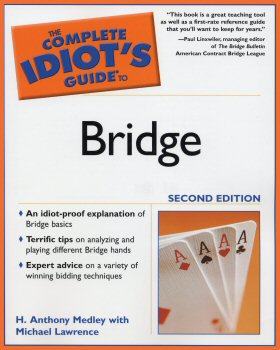| The first edition of Complete Idiot's Guide to Bridge by H. Anthony Medley was the fastest selling beginning bridge book, going through more than 10 printings. This updated Second Edition includes some modern advanced bidding systems and conventions, like Two over One, a system used by many modern tournament players, Roman Key Card Blackwood, New Minor Forcing, Reverse Drury, Forcing No Trump, and others. Also included is a detailed Guide to Bids and Responses, along with the most detailed, 12-page Glossary ever published, as well as examples to make learning the game even easier. Click book to order. | ||
| In Bruges (3/10) by Tony Medley There is an axiom that I have developed that when the Production Notes for a movie are so well written that they make the reader anxious to see the movie, the movie turns out to be dreck. The Production Notes for this film are as good as any I’ve read. Guess how much I loved the movie. Exacerbating that, there was a jerky critic at my screening who laughed out loud every time someone uttered a line. I don’t think that studios hire shills for small screenings like this, so maybe this guy was just a guy without a sense of humor of his own who had been lulled in by the Notes and programmed to laugh every time someone spoke. This is another in a line of silly Hollywood films about sensitive, likeable hit men. Pierce Brosnan made a terrific film (The Matador, 2005) on this subject, but that was the exception that proves the rule. Hit men are, by definition, psychopaths. Anyone who can kill someone else for money lacks human emotion and compassion. But the guys in this film, Ray (Colin Farrell) and Ken (Brendan Gleeson) are just ordinary chaps with ordinary feelings who just happen to kill people they don’t know for money. Characters like this, created by clueless writers like Martin McDonagh, who also directed, are grotesquely unrealistic. Farrell duplicates his neurotic performance in Cassandra’s Dream, only it’s not nearly as appealing. I hope Colin hasn’t fallen in love with that character. Bogey and Gable could be the same character in film after film and it was appealing. But when Bogey became neurotic in “The Treasure of Sierra Madre” (1948) and “The Caine Mutiny” (1954), he at least let six years pass between the two performances. Twice in one year is too much, Colin. In this foolish film, Ken and Ray have performed a hit and are ordered to run away to Bruges, in Belgium, to hide out for awhile. Poor Ray can’t get it out of his mind that he hit a little boy, so he’s neurotic about it. Ken tries to be a big brother to Ray, but their boss, Harry (Ralph Fiennes) has other ideas. McDonagh is in love with his directing, so he has scene after scene where the camera zeroes in on Ray or Ken as they think. I’m not talking about a reaction shot here. I’m talking about 15-20 seconds watching them think. And it’s not just once or twice. The first hour is full of these shots. Staying awake during the first hour requires superhuman stamina, so slow and self-indulgent is it. The film picks up a little in the last 53 minutes, but my watch took another beating as I was constantly looking at it while I endured this. This is apparently intended to be a comedy, which is why the jerk in my screening was laughing out loud every minute or so. I didn’t find it funny. It never occurred to me to laugh, or chuckle, or smile. This thing is full of Hollywood plot holes. Just one of which is when Ray gets on a train to run away from Bruges. Nobody knows he’s on the train but Ken; NOBODY! Despite this, a few minutes later he’s arrested for his specific crime by a policeman, who asks, “Are you Irish?” How the policeman could have known he was on a train, and that specific train, is beyond conjecture. Worse, right there with the policeman, on the train, are his accusers! “Yeah, that’s the guy,” they proclaim. I ask you, how many policemen take witnesses and accusers with them when they are on the trail of a criminal? Does zero sound about right? But not in a McDonagh movie, apparently. Whatever he needs to fit the story is what he’ll put in. Another plot hole occurs when a guy gets shot in the carotid artery. Hey, not to worry! The guy still has enough blood and energy left to climb up a bunch of steps and jump out of a window 250 feet high. After he lands on his head, squishing on the ground like a tomato, he still can talk and give instructions before he says, “I think I’m going to die now.” On the positive side, it is filmed on location in Bruges, which is the most well-preserved medieval city in all of Belgium. The sites are beautiful but I wasn’t blown away by the cinematography. I think they dropped the ball here, because it’s not a paean to the city as “The Sound of Music” (1965) was to Salzburg, which might have given it a little saving grace. Alas, ‘twas not to be. January 18, 2008
|
||
|
|
||
